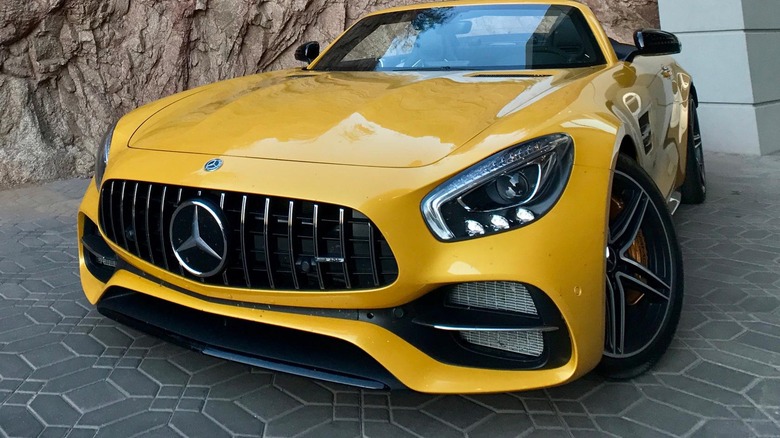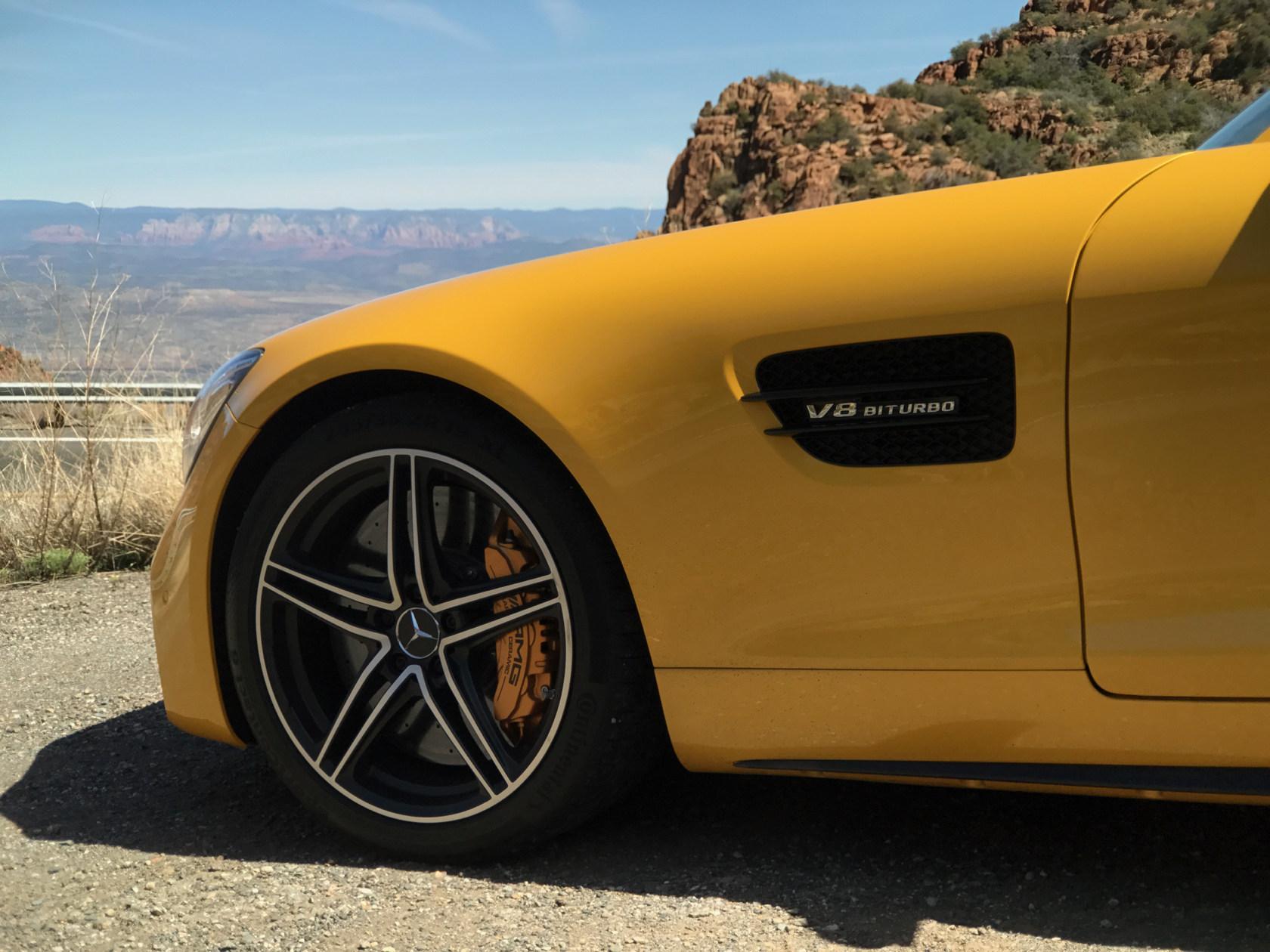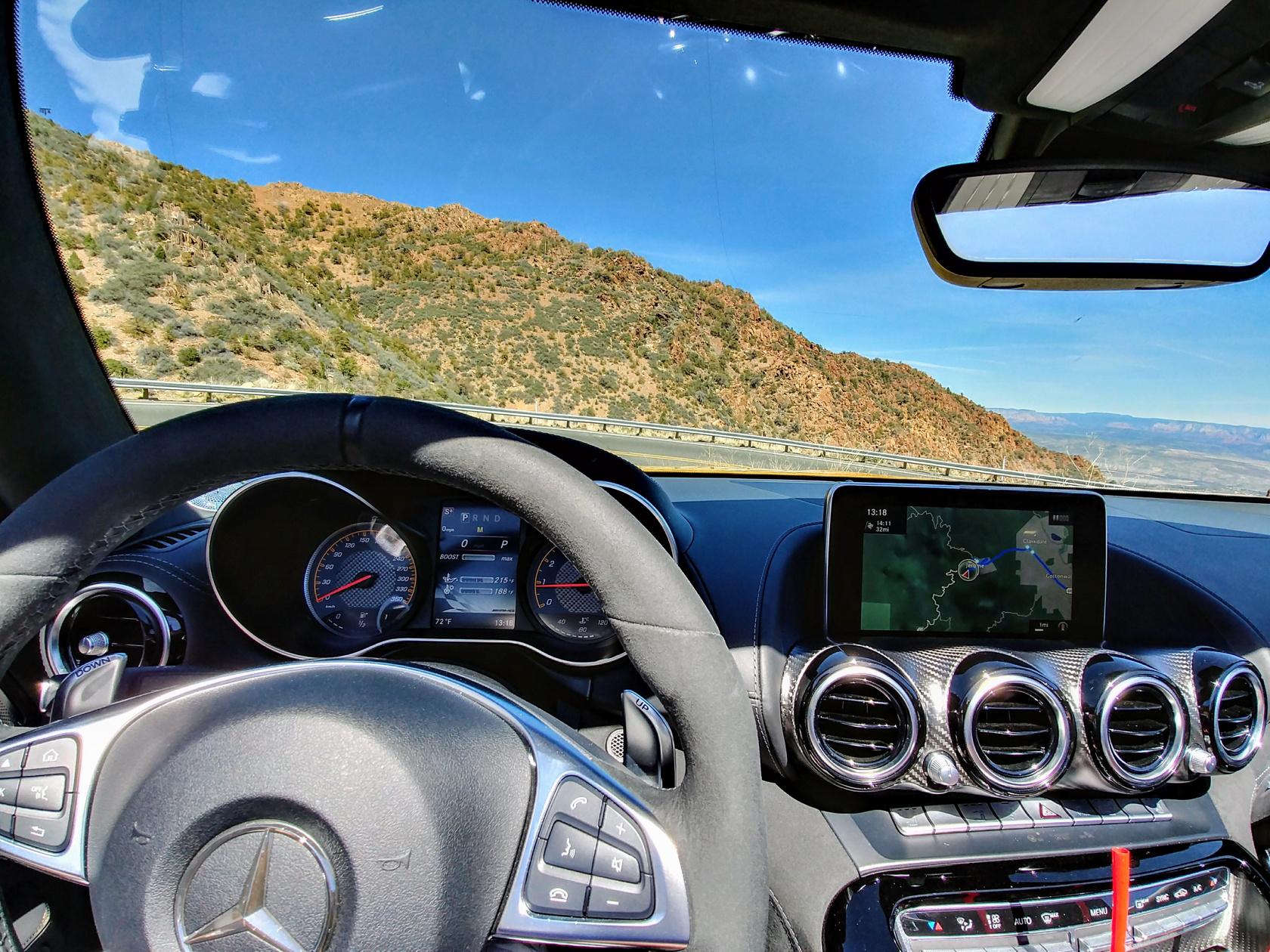2018 Mercedes-AMG GT C Roadster First Drive: A Silver Bullet
Luckily, my fun in the sun with Mercedes-AMG's new GT C Roadster in Arizona didn't come to a premature end when my driving partner got a speeding ticket. The topless Solarbeam Yellow GT cruiser shot out as though the canyon had just given birth to it... and that happened to be the exact spot where we drove past the state trooper. I sat quietly in the passenger seat as he explained to the officer, "it's this stupid car, it feels like it's going 60..." only to have the officer reply "you're really flying, I clocked you at 90 mph."

Even with police presence, the twists and long sweeping turns throughout our drive across Arizona was proved the perfect foil for Mercedes-AMG's most eye-catching car. With the ticket out of the way, we charged forward to one of the best section of the road, Route 89A, with more spiraling bends, deep canyons, and wide turns toward the old mining town of Jerome.
In my co-driver's defense, the GT C Roadster begs to be driven hard and we did exactly that. With 550 horsepower and 502 lb.-ft of torque under the hood and just itching to come out and play, you're bound to slip and get swept away in the moment. The hypnotic AMG Performance Exhaust does nothing to dissuade you, either, especially when the top is down. It's pretty much like the weather in Phoenix, where the temperature comes in two settings only: hot and hotter. In Mercedes-AMG's case the two exhaust modes are loud and louder.
You rouse that extra aural pleasure with a button on the center console. It hums along to just the right tune and, when you lift off the throttle, spurts out multiple snaps, crackles, and pops. I found myself downshifting early, not from any mechanical or driving need, but simply because it's gleefully fun. Speaking of shifting, the seven-speed AMG Speedshift dual-clutch transmission – complete with roadster-specific gearing ratios and calibration – does an exceptional job, especially in Sport+ or (exclusive to the C and R) Race mode.
I spent the bulk of my time behind the wheel plying the paddle shifters myself and in Sport+ mode, and couldn't help but be impressed with the near-instant upshifts and the rev-matching on downshifts. The 4.0-liter biturbo V8 engine also powers the "regular" AMG GT version with 469 HP and 465 lb-ft. of torque; the AMG engineering wizards tune it for 515 HP and 494 lb-ft. for the GT S Coupe, and finally a whopping 577 HP and 516 lb-ft. for the green-monster GT R. In a nutshell, the GT is fast while the GT S is, insanely, faster. We the majority of our 300+ mile drive in the GT C, it was plenty of time to see what the variable adaptive suspension has to offer, while exploiting the five drive modes (Individual, Comfort, Sport, Sport+ and Race).

Speaking to Jorg Letzel, Product Management at Mercedes-AMG, he confirmed that the GT C Roadster and GT R in fact share the same transmission. "There's a longer first gear for better acceleration," he explained, "with a shorter 7th gear in order to reach high speed even further, with the same high speed shifting time." Letzel also elaborated on the changes that take place when switching drive modes from Sport+ to Race: "the sound of the exhaust system, shorter shifting time, [and] throttle response time is more sensitive and the steering stiffens up." Depending on the driving mode, "starting from drive mode Comfort to Sport+, the spoiler pops up at 120+ km/h and under 80, it goes down. In race mode, the spoiler pops up at 70 km/h and down below 30 km/hr."
Probably wisely, Mercedes-AMG doesn't automatically turn off all the driver aids even in Race mode. "ESP remains on while maintaining Sport+ handling and the harshest dampening suspension," Letzel says. Even so, when you switch on Race mode everything is noticeably more direct, and the car feels like it reacts instantaneously. After a full day of driving you really start to understand the differences between the five modes, like the steering becoming much heavier in Race than it is in Sport+.
Rear-wheel steering is optional on the GT Roadster – it'll also be optional on the GT S Coupe in the near future – and comes standard on the GT C Roadster and GT R. It'll also be packaged in the AMG Dynamic Plus Package. The active rear-steering unit turns the rear wheels up to 1.5 degrees: at speeds below 62 mph, the rear wheels turn in opposite directions to the front which essentially shortens the wheel base. Conversely, the rear wheels turn in the same direction as the front at speeds above 62 mph, for better stability: in effect, AMG is mimicking a longer wheelbase car. You really get a sense of how quick things happen when you're passing slower-moving vehicles on windy two-land roads: pop out to the left lane, throttle to pass, and then cut neatly back in to the right lane. It's compellingly precise, and has you hungering to run into traffic if only to pass them.

Race mode's other big feature is launch control. Hold down the brake pedal with one foot, slam on the gas with the other, and then wait for the rev counter to hit its threshold – which you can actually modify using the paddle shifters – then release the brakes. We didn't time our 0-60, but the spec sheet suggests it takes just 3.7 seconds with a top speed of 196 mph for the GT C. The GT takes 4 seconds dead, and has a maximum speed of 188 mph. Peak torque is available from 1900 rpm, through 6000 rpm and then some.
Honestly, Mercedes-AMG's GT is possibly the purest of the Gran Tourismo cars I've driven. True to form, the front end is stretched out extra-long, though the engine itself is pushed toward the center of the car. If I didn't know better from real-world experience, I'd suspect that the rear end would kick out more often than not. To my surprise, in both normal and spirited driving, the back never once misbehaved. Not that it can't or won't happen, mind: push hard enough – especially with the ESC turned off – and it'll turn into a Ken Block-drift-happy machine. Thanks to the electronic limited-slip rear differential, wheel-spin rarely happens; it also allows for faster cornering and sharper turn-in and -out while keeping the car stable and planted.
It doesn't hurt that the GT C is much closer to the GT R in its rear track. The wider rear fenders look better, but they also allow for a 2.25-inch wider axle. That means Mercedes-AMG can fit 305/30/ZR20 tires, instead of the 295/30/ZR20's it uses on the GT.
As for the convertible, going topless in the GT Roadster adds another 55 pounds in weight, but that's not all bad. Indeed, a little extra weight over the back wheels doesn't hurt stability. The soft top itself swiftly opens and closes even while the car is moving, in less than 11 seconds. When up, wind and road noise is kept to an impressive minimum courtesy of three layers sandwiched together, even at speeds likely to be frowned upon by state troopers.
Design Elements
Whether you have the GT in coupe or convertible form, the new Mercedes-AMG is genuinely gorgeous, and frankly unlike anything else in the segment. I had the opportunity to pick the brain of Vitalis Enns, head of Mercedes-AMG interiors and exteriors, over dinner, and he was pretty insistent that the key to the car – and its style longevity, like the Mercedes grand tourers of old – is simplicity. "Keeping the design timeless means work with proportion, light, surfaces and volume," he explained to me. "You don't add lots of details, as soon as you add details and lines, it becomes fashionable. And fashion is, after three years-time, you want to get rid of it." This is especially true when you're spending $160,000 and up on a sports car.

The rear arch, for instance, isn't defined by lines but instead by how the light falls upon it and thus forms the shape of the car. On the front, Enns pointed out, the hard crease of a shut line is nonexistent and, instead, the GT plays with volume and clean surfacing for a more elegant, elongated hood. As for the grill, that flares open so that the car appears lower to the ground: the result is an aggressive, prowling stance.
"The front is the fascia of the car, and the face is the first expression, this is where you get the eye contact," Enns says. Instead of going with a more traditional V-shape, Enns flipped the design into an A-shape fascia which, with the LED lights on the sides, lends the appearance of the grille floating. Additional black elements below give the impression that the front is even wider. It's known as the "Panamericana" grille, delineated with thick vertical slats where the single chrome bar and Mercedes' emblem once was.

Short overhangs and a long hood stays true to the classic GT designs, flowing back into a high beltline. A dark hood purposely lowers the profile visually. The GT C adds a pair of vertical air outlets on each side, similar to those on the GT R, as well as a horizontal slit between the taillights. For Enns, these are the elements that the roadster a true GT: "a very high beltline, a very low rear, strength from the body side, muscular [rear quarter panel], and a very, very low rear."
With the engine shoved so far beyond the firewall, you can't help but feel snug inside the cabin. Perhaps intimate might be a better word to describe the feeling. It's not cramped, though, and I never felt uncomfortable during our 300-mile road trip. The AMG performance seats are supportive and handsome, while between them is a hulking center console, forced upon the interior due to the mid-engine placement. On the plus side, that does mean there's enough room for a pair of cup holders.

There's no shortage of luxury elements, either, from the carbon fiber trim to beautifully stitched leather and well-placed knobs and switches for the key functions. Mercedes' newest COMAND infotainment system is front and center, well positioned to be used by both driver and passenger. Even with the top down, the Burmester audio system is more than full-throated enough to keep you entertained, should the GT's own soundtrack not be enough. For chilly days, Airscarf – vents around the neck blowing out warm air – is more than sufficient to keep your warm even with the top down.
Unlike some droptop rivals, there's no hydraulically sprung roll bar that thrusts out in the event of a rollover. Instead, AMG uses a static roll cage which is lighter. If I had a complaint, it's that the thick A-pillar intrudes on your forward view at times, particularly when you're hunting for the apex during a hairpin turn. With two bodies inside there's not much room in the cabin for much else, so expect to pack light for a weekend getaway. There's enough space to fit a couple of duffle bags, though for golfers, the designers and engineers came up with a trunk where, with the quick removal of a cap, you can fit longer-than-average clubs.
Wrap-up
The AMG GT C Roadster and GT C Coupe is Mercedes' silver bullet against the likes of the Audi R8 V10 Plus, Aston Martin DB11, and Porsche 911. Expect to pay $124,400 upwards for the GT Roadster, and $157,000 for the GT C Roadster when they arrive in dealerships this summer. As for the hard-top, the AMG GT Coupe will be $112,400, rising to $132,400 for the GT S Coupe, $145,000 for the GT C Coupe, and finally $157,000 for the AMG GT R Coupe.
To be frank, at this sort of level – and with this sort of competition – you can't really make a wrong choice. After all, there's no "bad" car in this segment, only a matter of personal taste. With its combination of fierce performance and seductive design, I suspect Mercedes-AMG will have no shortage of interest when the order books open later this year.
Photo credit: Vincent Nguyen
















